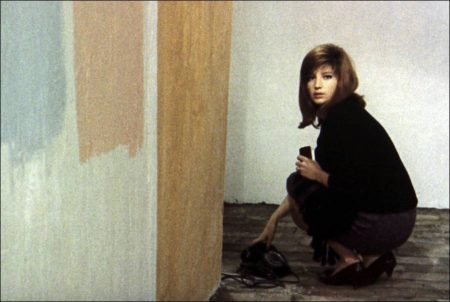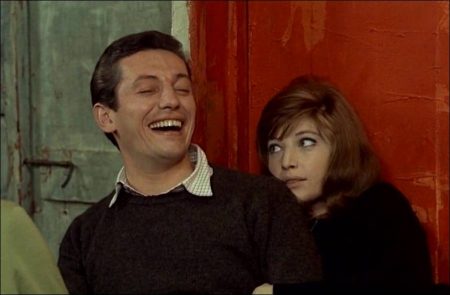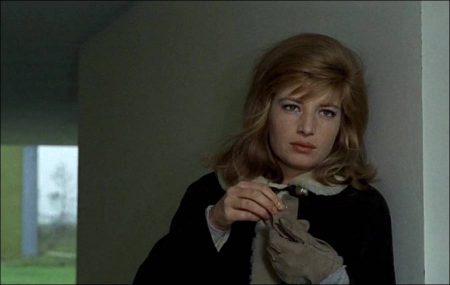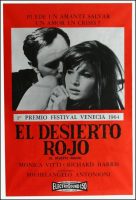Il Deserto Rosso movie storyline. Against the grim backdrop of Ravenna’s barren industrial wastelands brimming with flame-belching factories and deleterious chemical fumes, Giuliana, a deeply dejected young mother on the brink of a total existential breakdown, seeks solace in one of her neglectful husband’s handsome associates, Corrado Zeller.
Alienated after that horrible car accident and utterly disarmed by him, Giuliana shall embark on a hasty and shallow affair in the hope of overcoming the insurmountable obstacles of her profound, yet quiet mental anguish; however, her spiritual catharsis still seems so far away. In the end, is isolation Giuliana’s only refuge?
Il Deserto Rosso (English: Red Desert) is a 1964 Italian film directed by Michelangelo Antonioni and starring Monica Vitti with Richard Harris. Written by Antonioni and Tonino Guerra, it was Antonioni’s first color film. The story follows a troubled woman (Monica Vitti) living in an industrial region of Northern Italy following a recent automobile accident.
Il deserto rosso was awarded the Golden Lion at the 25th Venice Film Festival in 1964. It has received acclaim from critics.[1] This was the last in a series of four films he made with Vitti between 1959 and 1964, preceded by L’Avventura (1960), La Notte (1961), and L’Eclisse (1962).
About the Production
The working title of the film was Celeste e Verde (Sky blue and Green). Shooting took place in the following locations:
Incir De Paolis Studios, Rome, Lazio, Italy (studio)
Ravenna, Emilia-Romagna, Italy
Sardinia, Italy
Budelli, in northern Sardinia, Italy
The film is set in the industrial area of 1960s Ravenna with sprawling new post World War Two factories, industrial machinery and a much polluted river valley. The cinematography is highlighted by pastel colors with flowing white smoke and fog. The sound design blends a foley of industrial and urban sounds with ghostly ship horns and an abstract electronic music score by Gelmetti. This was Antonioni’s first colour film, which the director said he wanted to shoot like a painting on a canvas:
“I want to paint the film as one paints the canvas; I want to invent the colour relationships, and not limit myself to photographing only natural colours.”
As he would do in later film productions, Antonioni went to great lengths in reaching this goal, such as having trees and grass painted white or grey to fit his take on an urban landscape. Andrew Sarris called the red hued pipes and railings “the architecture of anxiety: the reds and blues exclaim as much as they explain”.

Another of Il deserto rosso’s innovating technical effect is extentive use of the telephoto and zoom lenses, even in shots where the actor stands relatively close to the camera. Antonioni wrote “I worked a lot in il deserto rosso with the zoom lens to try and get two dimensional effect, to diminish the distance between people and objects, make them seem flattened against each other. Such flattening contributes to the sense of psychological oppression : Guiliana in several shots seems pinned against the wall and the bars between couples seem part of their body.”
Antonioni dismissed simple interpretations of the film as a condemnation of industrialism, saying:
“It’s too simplistic to say—as many people have done—that I am condemning the inhuman industrial world which oppresses the individuals and leads them to neurosis. My intention… was to translate the poetry of the world, in which even factories can be beautiful. The line and curves of factories and their chimneys can be more beautiful than the outline of trees, which we are already too accustomed to seeing. It is a rich world, alive and serviceable… The neurosis I sought to describe in Red Desert is above all a matter of adjusting. There are people who do adapt, and others who can’t manage, perhaps because they are too tied to ways of life that are by now out-of-date.”
About the Story
In Ravenna, Italy, Giuliana (Monica Vitti) is walking with her young son, Valerio, towards the petrochemical plant managed by her husband, Ugo. Passing workers who are on strike, Giuliana nervously and impulsively purchases a half-eaten sandwich from one of the workers. They are surrounded by strange industrial structures and debris that create inhuman images and sounds.
Inside the plant, Ugo (Carlo Chionetti) is talking with a visiting business associate, Corrado Zeller (Richard Harris), who is looking to recruit workers for an industrial operation in Patagonia, Argentina. Ugo and Corrado converse comfortably in the noisy factory. Ugo tells Corrado that his wife, Giuliana, had a recent auto accident, and though she was physically unhurt, she has not been right mentally. That night in their apartment, Giuliana becomes highly agitated and fearful over a dream she had about sinking in quicksand. Ugo is unable to calm her or understand what she’s experiencing.
Attracted to Giuliana, Corrado visits her at an empty shop she’s planning to open and talks about his life and the restless nature of his existence. She accompanies him to Ferrara on one of his worker recruitment drives, and she indirectly reveals details about her mental state. She tells him that when she was in the hospital, she met a young woman patient who was advised by her doctors to find someone or something to love—a husband, a son, a job, even a dog. She speaks of the young woman feeling like there was “no ground beneath her, like she was sliding down a slope, sinking, always on the verge of drowning.” They travel to a radio observatory in Medicina, where Corrado hopes to recruit a top worker. Surrounded by cold industrial architecture, Giuliana seems lost in her loneliness and isolation.
The following weekend, Giuliana, Ugo, and Corrado are walking beside a polluted estuary where they meet up with another couple, Max and Linda, and together they drive to a small riverside shack at Porto Corsini where they meet Emilia. They spend time in the shack engaged in trivial small talk filled with jokes, role-playing, and sexual innuendo. Giuliana seems to find temporary solace in these mindless distractions.
A mysterious ship docks directly outside their shack, and as she looks out to the open sea, Giuliana confides to Corrado, “I can’t look at the sea for long or I lose interest in what’s happening on land.” During their conversations, Corrado and Giuliana have grown closer, and he shows interest and sympathy for her. Like Giuliana, Corrado is also alienated, but he is better adapted to and accepting of his environment, telling her, “You wonder what to look at; I wonder how to live.” When a doctor arrives to board the ship, Giuliana, seeing that the ship is now quarantined due to an infectious disease, rushes off in a state of panic. Her unwillingness to stay, or to return to the shack to retrieve the purse she left behind, underscores her state of alienation from the others.
Sometime later, Ugo leaves on a business trip, and Giuliana spends more time with Corrado, revealing more about her anxieties. One day she discovers that her son has apparently become suddenly paralyzed from the waist down. Fearing he has contracted polio, Giuliana tries to comfort her son with a story about a young girl who lives on an island and swims off a beach at an isolated cove. The girl is at home with her surroundings, but after a mysterious sailing ship approaches offshore, all the rocks of the cove seem to come alive and sing to her in one voice. Soon after, Giuliana discovers to her shock that Valerio was only pretending to be paralyzed. Unable to imagine why her son would do such a cruel thing, Guiliana’s sense of loneliness and isolation returns.
Il Deserto Rosso (1964)
Directed by: Michelangelo Antonioni
Starring: Monica Vitti, Richard Harris, Carlo Chionetti, Xenia Valderi, Rita Renoir, Lili Rheims, Aldo Grotti, Emanuela Pala Carboni, Valerio Bartoleschi, Hiram Mino Madonia
Screenplay by: Michelangelo Antonioni, Tonino Guerra
Production Design by: Ugo Tucci
Cinematography by: Carlo Di Palma
Film Editing by: Eraldo Da Roma
Costume Design by: Gitt Magrini
Art Direction by: Piero Poletto
Music by: Giovanni Fusco, Vittorio Gelmetti
MPAA Rating: None.
Distributed by: Rizzoli (USA)
Release Date: September 7, 1964 (VFF), February 8, 1965 (US)
Views: 369



